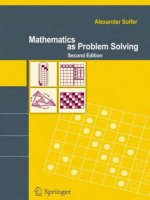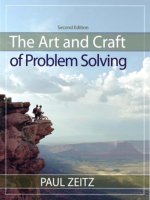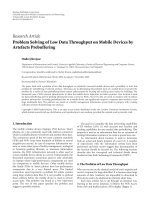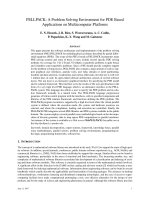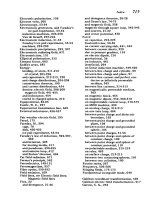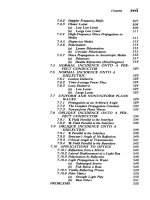Mathematics as Problem Solving
Bạn đang xem bản rút gọn của tài liệu. Xem và tải ngay bản đầy đủ của tài liệu tại đây (1.69 MB, 120 trang )
Mathematics
as Problem Solving
Second Edition
Alexander Soifer
Mathematics
as Problem Solving
Second Edition
Alexander Soifer
College of Letters, Arts and Sciences
University of Colorado at Colorado Springs
1420 Austin Bluffs Parkway
Colorado Springs, CO 80918
USA
ISBN: 978-0-387-74646-3 e-ISBN: 978-0-387-74647-0
DOI: 10.1007/978-0-387-74647-0
Library of Congress Control Number: 2009921736
Mathematics Subject Classification (2000): 00-XX, 00A05, 00A07, 00A08, 00A35, 97A20, 05CXX,
05C15, 05C55, 05-XX
©
Alexander Soifer 2009
All rights reserved. This work may not be translated or copied in whole or in part without the written
permission of the publisher (Springer Science+Business Media, LLC, 233 Spring Street, New York, NY
10013, USA), except for brief excerpts in connection with reviews or scholarly analysis. Use in connection
with any form of information storage and retrieval, electronic adaptation, computer software, or by similar
or dissimilar methodology now known or hereafter developed is forbidden.
The use in this publication of trade names, trademarks, service marks, and similar terms, even if they are
not identified as such, is not to be taken as an expression of opinion as to whether or not they are subject
to proprietary rights.
Cover designed by Mary Burgess
Printed on acid-free paper
springer.com
To Mark and Julia Soifer
Frontispiece reproduces the front cover of the original edition. It was
designed by my later father Yuri Soifer, who was a great artist. Will
Robinson, who produced a documentary about him for the Colorado
Springs affiliate of ABC, called him “an artist of the heart.” For his first
American one-man show at the University of Colorado in June–July
1981, Yuri sketched his autobiography:
I was born in 1907 in the little village Strizhevka in the Ukraine. From
the age of three, I was taught at the Cheder (elementary school by a syna-
gogue), and since that time I have been painting. At the age of ten, I entered
Feinstein’s Jewish High School in the city of Vinniza. The art teacher, Abram
Markovich Cherkassky, a graduate of the Academy of Fine Arts at St. Peters-
burg, looked at my book of sketches of praying Jews, and consequently taught
me for six years, until his departure for Kiev. Cherkassky was my first and
most important teacher. He not only critiqued my work and explained vari-
ous techniques, but used to sit down in my place and correct mistakes in my
work until it was nearly unrecognizable. I couldn’t then touch my work and
continue – this was unforgettable.
In 1924, when I was 17, my relative, the American biologist, who later
won the Nobel Prize in 1952, Selman A. Waksman, offered to take me to the
United States to study and become an artist, and to introduce me to Cha-
gall, but my mother did not allow this, and I went to Odessa to study at the
Odessa Institute for the Fine Arts in the studio of Professor Mueller. Upon
graduation in 1930, I worked at the Odessa State Jewish Theater, and a year
later became the chief set and costume designer. In 1934, I came to Moscow
to design plays for Birobidzhan Jewish Theater under the supervision of the
great Michoels. I worked for the Jewish newspaper Der Emes, the Moscow
Film Studio, Theater of Lenin’s Komsomol, and a permanent National Agri-
cultural Exhibition. Upon finishing my 1941–1945 service in World War II,
I worked for the National Exhibition in Moscow, VDNH.
All my life, I have always worked in painting and graphics. Besides por-
traits and landscapes in oil, watercolor, gouache, and marker (and also acrylic
upon the arrival in the USA), I was always inspired (perhaps, obsessed) by
the images and ideas of the Russian Civil War, Word War II, biblical stories,
and the little Jewish village that I came from.
The rest of my biography is in my works!
Front cover of the first edition, 1987, by Yuri Soifer.
Foreword
This book joins several other books available for the preparation of
young scholars for a future that involves solving mathematical prob-
lems.
This training not only increases their fitness in competitions, but
may also help them in other endeavors they may engage in the future.
The book is a diversified collection of problems from all areas of
high school mathematics, and is written in a lively and engaging way.
The introductory explanations and worked problems help guide
the reader without turning the additional problems into rote repeti-
tions of the solved ones.
The book should become an essential tool in the armamentarium
of faculty involved with training future competitors.
Branko Gr
¨
unbaum
Professor of Mathematics
University of Washington
June 2008, Seattle, Washington
Foreword
This was the first of Alexander Soifer’s books, I think, preceding How
Does One Cut a Triangle? by a few years. It is short on anecdote and
reminiscence, but there is charm in its youthful brusqueness and let’s-
get-right-to-business muscularity. And, mainly, there is a huge lode of
problems, very good ones worked out and very good ones left to the
reader to work out.
Every mathematician has his or her bag of tricks, and perhaps ev-
ery mathematician will find some part of this book to view with smug
condescension, but there may not be a mathematician alive that can
so view all of this book. I notice that Paul Erd
˝
os registered his ad-
miration for the chapters on combinatorics and geometry. For me, the
Pigeonhole Principle problems were fascinating, exotic, and hard, and
I would like to base a course on that section and on parts of the chap-
ters on combinatorics and geometry.
Anyone coaching a Putnam Exam team should have a copy of this
book, and anyone trying out for a Putnam Exam team would do well
to train with this book. Training for prize exams is a good entree to
higher mathematics, but even if you are not a competitive type, this
book could well be the portal that will lead you into the wonderful
world of mathematics.
Peter D. Johnson, Jr.
Professor of Mathematics
Auburn University
June 12, 2008, Auburn, Alabama
Foreword
In Mathematics as Problem Solving, Alexander Soifer has given an ap-
proach to problem solving that emphasizes basic techniques and
thought rather than formulas. As he writes in the introduction to
Chapter 2 (Numbers),
Numerous beautiful results could be presented here, but I will limit
myself to problems illustrating some ideas and requiring practically
no knowledge of number theory.
The chapter headings are
•
Language and a Few Celebrated Ideas
•
Numbers
•
Algebra
•
Geometry
•
Combinatorial Problems
Each topic is suitable for high school students, and there is a pleas-
ant leanness to the list of topics (compare this with a current calculus
text). The Chinese Remainder Theorem is out; the Pigeonhole Prin-
ciple is in. As the reader will at some point discover, the Chinese
Remainder Theorem can be deduced from the Pigeonhole Principle.
Now is the time for fundamental problem solving; first things first. At
the same time, nontrivial ruler and compass construction problems
are basic to a proper understanding of geometry. Dr. Soifer has made
a wise choice to emphasize this topic.
xii Foreword
The 200 or so problems are well chosen to go with the emphasis
on fundamental techniques, and they provide a rich resource. Some of
the problems are appropriately routine, while some others are “little
results” found by mathematicians in the course of their research. For
example, Problem 1.29 is a rewording of a result mentioned in a sur-
vey paper by Paul Erd
˝
os; the discovery was originally made by Erd
˝
os
and V.T. S
´
os. This problem also appeared on the 1979 USA Mathemat-
ical Olympiad.
1.29 (First Annual Southampton Mathematical Olympiad,
1986) An organization consisting of
n
members (
n > 5
) has
n +1
three-member committees, no two of which have identi-
cal membership. Prove that there are two committees in which
exactly one member is common.
Mathematics as Problem Solving is an ideal book with which to begin
the study of problem solving. After readers have gone on to study
more comprehensive sources, Mathematics as Problem Solving is likely
to remain in a place of honor on their bookshelf.
Cecil Rousseau
Professor of Mathematics
Memphis State University
June 2008, Memphis, Tennessee
Preface to the Second Edition
The moving power of mathematical invention is not
reasoning but imagination.
Augustus de Morgan
I released this book over twenty years ago. Since then she lived her
own life, quite separately from me. Let me briefly trace her life here.
In March 1989, her title, Mathematics as Problem Solving, became
the first “standard for school mathematics” of the National Council
of Teachers of Mathematics [2]. In 1995, her French 4000-copy edi-
tion, Les math´ematiques par la r´esolution de probl`emes,
´
Editions du Choix,
quickly sold out.
She was found charming and worthy by Paul Erd
˝
os, Martin Gard-
ner, George Berszenyi, and others:
The problems faithfully reflect the world-famous Russian school of
mathematics, whose folklore is carefully interwoven with more tra-
ditional topics. Many of the problems are drawn from the author’s
rich repertoire of personal experiences, dating back to his younger
days as an outstanding competitor in his native Russia and span-
ning decades and continents as an organizer of competitions at the
highest level. – George Berzsenyi
The book contains a very nice collection of problems of various dif-
ficulties. I particularly liked the problems on combinatorics and ge-
ometry. – Paul Erd
˝
os
Professor Soifer has put together a splendid collection of elementary
problems designed to lead students into significant mathematical
concepts and techniques. Highly recommended. – Martin Gardner
xiv Preface to the Second Edition
In the “extended” American Mathematical Monthly review, Cecil
Rousseau paid her a high compliment:
Retelling the best solutions and sharing the secrets of discovery are
part of the process of teaching problem solving. Ideally, this process
is characterized by mathematical skill, good taste, and wit. It is a
characteristically personal process and the best such teachers have
surely left their personal marks on students and readers. Alexander
Soifer is a teacher of problem solving and his book, Mathematics as
Problem Solving, is designed to introduce problem solving to the
next generation.
This poses a problem: how does one reach out to the next gener-
ation and charm it into reading and doing mathematics? I am deeply
grateful to Ann Kostant for solving this problem by inviting a new
edition of this book into the historic Springer. I thank Col. Dr. Robert
Ewell for converting my sketches into real illustrations. I am so very
grateful to the first readers of this manuscript, Branko Gr
¨
unbaum, Pe-
ter D. Johnson, Jr., and Cecil Rousseau for their comments and fore-
words.
For the expanded Springer edition, I have added a sixth chapter
dedicated to my favorite problem of the many problems that I have
created, “Chess
7 × 7
.” I found three beautiful solutions to it. More-
over, this problem was inspired by the “serious” mathematics of Ram-
sey Theory, and once it was solved, it led me back to the “serious”
mathematics of finite projective planes. I hope you will enjoy this ad-
ditional chapter.
Let me mention for those who would like to read my other book
that this book was followed by the books [9, 1, 10] listed in the bibli-
ography. Then there came The Mathematical Coloring Book [11], after 18
years of writing. Books [12] and [13] will follow soon, as will new ex-
panded editions of the books [9, 1, 10]. All my books will be published
by Springer.
Write back to me; your solutions, problems, and ideas are always
welcome!
Alexander Soifer
Colorado Springs, Colorado
May 8, 2008
Preface to the First Edition
Remember but him, who being demanded, to what
purpose he toiled so much about an Art, which could
by no means come to the knowledge of many. Few are
enough for me; one will suffice, yea, less than one will
content me, answered he. He said true: you and another
are a sufficient theatre one for another; or you to your
selfe alone!!
Michel de Montaigne
Of Solitarinesse. Essayes [6]
I was fortunate to grow up in the problem-solving atmosphere of
Moscow with its mathematical clubs, schools, and Olympiads. The
material for this book stems from my participation in numerous math-
ematical competitions of all levels, from school to national, as a com-
petitor, an organizer, a judge, and a problem writer; but most impor-
tantly, from the mathematical folklore I grew up on.
This book contains about 200 problems, over one-third of which
are discussed in detail, sometimes even with two or more solutions.
When I started, I thought that beauty, challenge, elegance, and sur-
prising results and solutions alone would determine my choices. Dur-
ing my work, however, one more factor powerfully forced itself into
account: the interplay of selected problems.
This book is written for high school and college students, teachers,
and everyone else desiring to experience the mystery and beauty of
mathematics. It can be and has been used as a text for an undergrad-
uate or graduate course or workshop on problem solving.
Auguste Renoir once said that just as some people all their lives
read one book (the Bible, for example), so could he paint all his life one
painting. I cannot agree with him more. This is the book I am going
to write all my life. That is why I welcome so much your comments,
corrections, ideas, alternative solutions, and suggestions to include
other methods or to cover other areas of mathematics. Do send me
xvi Preface to the First Edition
your ideas and solutions: best of them as well as the names of their
authors will be included in the future revised editions of this book. I
hope, though, that this book will never reach the intimidating size of
a calculus text.
One can fairly make an argument that this book is raw, unpol-
ished. Perhaps that is not all bad: sketches by Modigliani give me, for
one, so much more than sweated-out oils of Old Masters. Maybe a
problem-solving book ought to be a sketch book!
To assign true authorship to these problems is as difficult as to
folklore tales. The few references that I have given indicate my source
rather than a definitive reference to the first mentioning of a prob-
lem. Even problems that I created and published myself might have
existed before I was born!
I thank Valarie Barnes for bravely agreeing to type this manuscript;
it was her first encounter of the mathematical kind. I thank my stu-
dent Richard Jessop for producing such a masterpiece of typesetting
art.
I am grateful to my parents Yuri and Rebbeca for introducing me
to the world of arts, and to my children Mark and Julia for inspira-
tion. My special thanks go to the first judges of this manuscript, my
students in Colorado Springs and Southampton for their enthusiasm,
ideas, and support.
A. Soifer
Colorado Springs, Colorado
November 1986
Contents
Foreword by Branko Gr ¨unbaum
.........................
ix
Foreword by Peter D. Johnson, Jr.
........................
x
Foreword by Cecil Rousseau
............................
xi
Preface to the Second Edition
...........................
xiii
Preface to the First Edition
.............................
xv
1 Language and Some Celebrated Ideas
.................
1
1.1 Streetcar Stories . . . . . . . . . . . . . . . . . . . . . . . . . . . . . . . . . . . . . 1
1.2 Language . . . . . . . . . . . . . . . . . . . . . . . . . . . . . . . . . . . . . . . . . . 3
1.3 Arguing by Contradiction . . . . . . . . . . . . . . . . . . . . . . . . . . . . 6
1.4 Pigeonhole Principle . . . . . . . . . . . . . . . . . . . . . . . . . . . . . . . . 8
1.5 Mathematical Induction . . . . . . . . . . . . . . . . . . . . . . . . . . . . . 12
2 Numbers
.........................................
19
2.1 Integers . . . . . . . . . . . . . . . . . . . . . . . . . . . . . . . . . . . . . . . . . . . . 19
2.2 Rational and Irrational Numbers . . . . . . . . . . . . . . . . . . . . . . 22
3 Algebra
..........................................
27
3.1 Proof of Equalities and Inequalities . . . . . . . . . . . . . . . . . . . 27
3.2 Equations, Inequalities, Their Systems, and How to
Solve Them . . . . . . . . . . . . . . . . . . . . . . . . . . . . . . . . . . . . . . . . 33
xviii Contents
4 Geometry
........................................
45
4.1 Loci . . . . . . . . . . . . . . . . . . . . . . . . . . . . . . . . . . . . . . . . . . . . . . . 45
4.2 Symmetry and Other Transformations . . . . . . . . . . . . . . . . . 48
4.3 Proofs in Geometry . . . . . . . . . . . . . . . . . . . . . . . . . . . . . . . . . 54
4.4 Constructions . . . . . . . . . . . . . . . . . . . . . . . . . . . . . . . . . . . . . . 60
4.5 Computations in Geometry . . . . . . . . . . . . . . . . . . . . . . . . . . 67
4.6 Maximum and Minimum in Geometry . . . . . . . . . . . . . . . . 71
5 Combinatorial Problems
............................
77
5.1 Combinatorics of Existence . . . . . . . . . . . . . . . . . . . . . . . . . . . 77
5.2 How Can Coloring Solve Mathematical Problems? . . . . . . 81
5.3 Combinatorics of Sets . . . . . . . . . . . . . . . . . . . . . . . . . . . . . . . 88
5.4 A Problem of Combinatorial Geometry . . . . . . . . . . . . . . . . 92
6 Chess 7
×
7
.......................................
93
7 Farewell to the Reader
..............................
103
References
..........................................
105
1
Language and Some Celebrated Ideas
1.1 Streetcar Stories
I would like to start our discussion with the following stories.
Streetcar Story I
You enter a streetcar with six other passengers on the first stop of its
route. On the second stop, four people come in and two get off. On
the third stop, seven people come in and five get off. On the fourth
stop, eight people come in and three get off. On the fifth stop, thirteen
people come in and eight get off.
How old is the driver?
Did you start counting passengers in the streetcar? If you did, here
is your first lesson: Do not start solving a problem before you read it!
Sounds obvious? Perhaps you are right. But you should not un-
derestimate its importance. I for one underestimated some obvious
things in life, and had to learn the hard way lessons like, “Do not read
while you drive!”
The story above does not give us any information relevant to the
age of the driver. However, relevance of information is not always
obvious.
Streetcar Story II
The reunion of two friends in a streetcar sounded like this:
Mathematics as Problem Solving 1A. Soifer, OI: 10.1007/978-0-387-74647-0_1,, D
© Alexander Soifer 2009
2 1 Language and Some Celebrated Ideas
— How are you? Thank you, I am fine.
— You just got married when we met last. Any children?
— I have three kids!
— Wow! How old are they?
— Well, if you multiply their ages, you would get 36; but if you
add them up, you’d get the number of passengers in this streetcar.
— Gotcha, but you did not tell me enough to figure out their ages.
— My oldest kid is a great sportsman.
— Aha! Now I know their ages!
Find the number of passengers in the streetcar and the ages of the
children.
Can the statement “my oldest kid is a great sportsman” have any
relevance? It can. In fact, it does! Moreover, the fact that without this
statement the second friend cannot figure out the ages of the children
carries valuable information, too!
Let us take a look at the following table:
Decompositions of
36 into 3 factors
x
,
y
,
z
The sum
x + y + z
1 · 1 · 36
38
1 · 2 · 18
21
1 · 3 · 12
16
1 · 4 · 9
14
1 · 6 · 6
13
2 · 2 · 9
13
2 · 3 · 6
11
3 · 3 · 4
10
The fact that the second friend was unable to figure out the ages
x
,
y
,
z
of the children when he knew their sum
x + y + z
implies that
there must be at least two solutions for the given sum
x+y+z
of ages!
The table shows that only 13 appears twice in the column
x + y + z
;
therefore,
x+y+z = 13
, and we know the number of passengers! We
can also see the relevance of the oldest kid being a great sportsman: it
rules out 1, 6, 6 and leaves 2, 2, 9!
1.2 Language 3
1.2 Language
As with any other science, mathematics is formulated in an ordinary
language — English in the United States. It is essential to use language
correctly as well as to correctly interpret sentences. I have no intention
to discuss formal mathematical language. I would like, however, to
briefly talk about constructing complex sentences, and to define the
meaning of “not”, “and”, “or”, “imply,” “if and only if”, etc.
We will deal only with statements that are clearly true or false in a
given context.
Here are a few examples of such statements:
(1) Chicago is the capital of the United States.
(2) One yard is equal to three feet.
(3) Any sports car is red.
(4) Any Ferrari is red.
As you can see, the first and third statements are false and the second
statement is true. It took me a visit to my friend Bob Penkhus, a car
dealer, to find out that the fourth statement is false.
The truth or falsity of a composite statement is completely deter-
mined by the truth or falsity of its components.
Negation
Given a statement
A
. The negation of
A
, denoted by
¬A
and read
“not
A
,” is a new statement, which is understood to assert that “
A
is
false.”
Let 1 stand for true and 0 stand for false. Then the following table
defines the values of
¬A
:
A ¬A
1
0
0 1
i.e.,
¬A
is false when
A
is true, and
¬A
is true when
A
is false.
Conjunction
Given statements
A
and
B
. The conjunction of
A
and
B
, denoted
A∧ B
and read “
A
and
B
,” is a new statement which is understood to
assert that “
A
is true and
B
is true.” The following truth table defines
A ∧ B
:
4 1 Language and Some Celebrated Ideas
A B A ∧ B
1 1
1
1 0 0
0 1 0
0 0 0
Disjunction
Given statements
A
and
B
. The disjunction of
A
and
B
, denoted
A ∨
B
, and read “
A
or
B
,” is a new statement that is understood to assert
“at least one of the statements
A
,
B
is true.” The following truth table
defines
A ∨ B
:
A B A ∨ B
1 1 1
1 0 1
0 1 1
0 0 0
Implication
Given statements
A
and
B
. The implication
A ⇒ B
,toberead“
A
implies
B
,” is a statement that is understood to assert that “if
A
is
true, then
B
is true.” It is defined by the following truth table:
A B A ⇒ B
1 1 1
1 0 0
0 1 1
0 0 1
Please note that the meaning of “implication” in mathematics is quite
different from the common language use of this word:
A ⇒ B
is false
only if
A
is true and
B
is false.
Equivalence
Given statements
A
and
B
. The equivalence
A ⇔ B
,toberead“
A
equivalent
B
,” is an abbreviation for the following statement:
(A ⇒ B) ∧ (B ⇒ A).
1.2 Language 5
In order to uniquely interpret a composite statement, we some-
times need to use lots of parentheses. This can make a statement quite
difficult to read or evaluate. We can resolve this problem exactly the
same way we do in arithmetic: by establishing the order of operations
in a parenthesis-free composite statement:
We apply
¬
first
∧
second
∨
third
⇒
fourth
⇔
fifth.
Finally, a composite statement that is true regardless of the truth or
falsity of its components is called a tautology.
Problems
Prove the following tautologies:
1.1.
A ⇒ A
1.2.
A ⇒ A ∨ B
1.3.
A ∧ B ⇒ A
1.4.
¬¬A ⇔ A
1.5.
¬(A ∨ B) ⇔¬A ∧¬B
(De Morgan’s Law)
1.6.
¬(A ∧ B) ⇔¬A ∨¬B
(De Morgan’s Law)
1.7.
(A ⇒ B) ∧ (B ⇒ C) ⇒ (A ⇒ C)
1.8.
(¬B ⇒¬A) ⇔ (A ⇒ B)
1.9.
(A ∧¬B ⇒¬A) ⇒ (A ⇒ B)
1.10.
(A ∧¬B ⇒
F
) ⇒ (A ⇒ B)
,(
F
denotes a false statement)
6 1 Language and Some Celebrated Ideas
From now on we will use symbols:
∧
for “and”
∨
for “or”
⇒
for “implies”
⇔
for “if and only if”
¬
for “not”
∃
for “there exists”
∀
for “for every”.
If
A ⇒ B
is true, we say that
A
is a sufficient condition for
B
;at
the same time, we say that
B
is a necessary condition for
A
.If
A ⇔ B
is true, then
B
is said to be a necessary and sufficient condition for
A
.
Please remember that a statement converse to
A ⇒ B
is
B ⇒ A
.A
statement opposite to
A ⇒ B
is
¬(A ⇒ B)
.
1.3 Arguing by Contradiction
Problems 1.9 and 1.10 presented the following tautologies:
(A ∧¬B ⇒¬A) ⇒ (A ⇒ B)
(A ∧¬B ⇒
F
) ⇒ (A ⇒ B).
These two tautologies justify a celebrated method of mathematical
proof: arguing by contradiction.
Let us say we are given that
A
is true and we are asked to prove
that
B
is true. We assume that
B
is not true — i.e.,
¬B
is true — and
then start with
A
and
¬B
and continue deducing until we arrive at a
contradiction to what is given — i.e., at
¬A
— what is known to be
true.
1.11. Prove the sum of a rational number and an irrational number is
an irrational number.
Proof. Let
r
be a rational number (i.e.,
r = m/n
for some integers
m,n
with
n = 0
), and let
i
be an irrational number (i.e.,
i
cannot be
presented in the form
s/t
, where
s, t
are integers and
t = 0
).
1.3 Arguing by Contradiction 7
Assume that the sum
r + i
is a rational number, say
r
1
. Then if
r
1
= p/q
for integers
p
,
q
, with
q = 0
,weget
r + i = r
1
i = r
1
− r
i =
p
q
−
m
n
i =
np− mq
nq
.
That is,
i
is a rational number, which contradicts the given fact that
i
is an irrational number. Therefore,
r + i
is irrational.
1.12. (Pigeonhole Principle)If
kn+1
pigeons (
k
,
n
are positive integers)
are placed in
n
pigeonholes, then at least one of the holes contains at
least
k + 1
pigeons.
Proof. Assume that there are no holes that contain at least
k + 1
pi-
geons. Then:
the 1st hole contains
≤ k
pigeons
the 2nd hole contains
≤ k
pigeons
.
.
.
+
the
n
th hole contains
≤ k
pigeons
total number of pigeons
≤ k × n
pigeons
This contradicts the given fact that there are
kn+1
pigeons. Therefore,
there is a hole that contains at least
k + 1
pigeons.
Problems
1.13. Prove that the product of a nonzero rational number and an ir-
rational number is again an irrational number.
As you probably know, a positive integer greater than 1 is called
prime if it has exactly two divisors, 1 and itself. The Fundamental The-
orem of Arithmetic states that any positive integer greater than 1 can
be decomposed into the product of prime numbers and that this de-
composition is unique up to the order of factors.
8 1 Language and Some Celebrated Ideas
1.14. Given a prime
p
and a positive integer
n
. Prove that if
n
2
is di-
visible by
p
, then
n
is divisible by
p
.
1.15. Prove that
√
6
is an irrational number.
1.16. A known theorem states that any point
C
of the perpendicular
bisector of a segment
AB
is equidistant from
A
and
B
. Prove the con-
verse.
1.17. A known theorem states that if a convex quadrilateral is in-
scribed in a circle, then the sums of its opposite angles are equal. Prove
the converse.
1.18. A known theorem states that
m =
a+b
2
, where
m
is the length of
the median and
a
,
b
are the lengths of the parallel bases of a trapezoid.
Prove the converse.
1.4 Pigeonhole Principle
In Section 1.3 we proved the Pigeonhole Principle, also known as the
Dirichlet Principle (after its inventor, the famous mathematician Peter
Gustav Dirichlet, 1805–1859). This simple principle does wonders. It
is amazing how easy it is to understand this idea, and how difficult it
sometimes is to discover that this idea can be applied! When you look
at the problems that are solved by the Pigeonhole Principle, many of
them appear to have nothing in common with each other. That is why,
in April 1986, I called my lecture for the participants of the Colorado
Springs Mathematical Olympiad “Invisible Pigeonhole Principle”.
1.19. New York City has 7,500,000 residents. The maximal number of
hairs that can grow on a human head is 500,000. Prove that there are
at least 15 residents in New York City with the same number of hairs.
Solution. Let us set up 500,001 pigeonholes labeled by integers the 0
to 500,000, and put residents of New York into the holes labeled by the
number of hairs on their heads. Since
7,500,000 > 14× 500,001+ 1
we conclude by the Pigeonhole Principle that there is a pigeonhole
with at least
14+ 1
pigeons, i.e., there are at least 15 residents of New
York with the same number of hairs.
